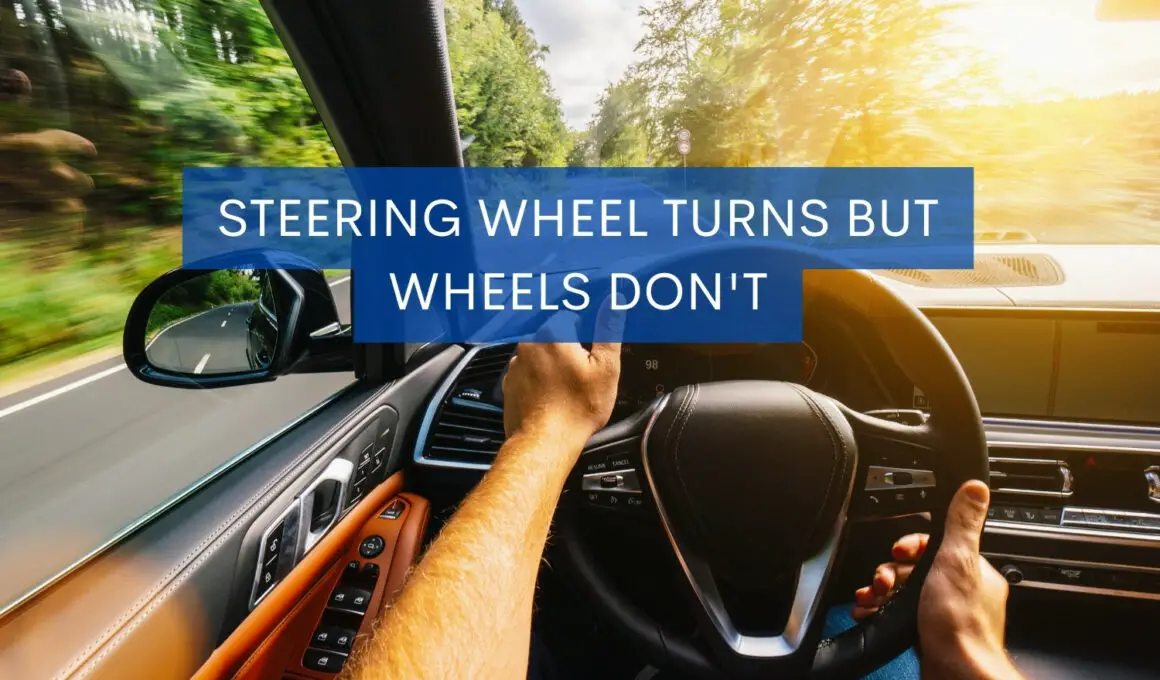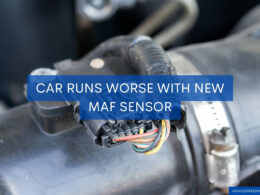In This Article Show
Over the years, with testing, getting customer complaints, and writing about cars, I often encounter a common yet potentially hazardous issue when a car’s steering wheel turns, but the wheels don’t. If you’ve ever found yourself in this situation, you know how alarming it can be. The instant loss of control and unpredictability is not just scary; it’s a downright safety risk.
It is crucial to understand, diagnose, and, most importantly, fix this problem. This isn’t about becoming an expert mechanic overnight but about equipping yourself with enough knowledge to tackle an unforeseen situation. More so, to ensure you maintain your vehicle properly to avoid facing such a predicament in the first place.
I’ve always advocated for preventative measures throughout my career as a mechanic and as a writer on this blog. Armed with the right knowledge, you can save yourself from unnecessary cost, time, and the potential risk associated with this steering issue.
So, let’s dig into it. Over the course of this post, I’ll guide you through why your steering wheel might turn without the wheels moving, the possible causes, how to diagnose it, and, importantly, the effective ways to fix it. And remember, while DIY spirit is admirable, knowing when to seek professional help can be just as crucial.
Understanding the Steering System
A car’s steering system, though simple in its function, is a complex assembly of various mechanical components. It’s what connects you, the driver, to the wheels and the road. As a mechanic with years of experience under my belt, I can tell you this: knowing how this system works will deepen your appreciation for the engineering marvel that is your car and allow you to identify issues quicker and understand their potential fixes.
At its core, when you turn the steering wheel, that input is transferred through various parts (like the steering column, steering gear, and finally to the steering arms) which then cause the wheels to turn in the desired direction.
The type of steering system in your car can vary. Some vehicles use a rack-and-pinion steering system, which is commonly found in most modern cars due to its simple and effective design. Others might use a recirculating ball or worm and sector steering, which are more common in older or heavier vehicles.
A crucial component of most modern steering systems is the power steering mechanism. Power steering uses hydraulic or electric power to assist you, making the steering wheel easier to turn, especially while parking or driving at slow speeds.
It’s important to note that any failure or malfunction in these components can lead to issues with steering. As we’re discussing today, one of these issues is when the steering wheel turns, but the wheels don’t.

Common Causes of the Problem
If your steering wheel turns but the wheels don’t, it often indicates an issue within your steering system. While this is definitely a cause for concern, remember that it’s usually a fixable problem. The key lies in correctly identifying the cause.
Here are some of the most common reasons why steering wheel turns but wheels don’t:
1. Faulty Steering Rack or Gear Box
The rack-and-pinion gear or the steering gear box is what converts the turning of the steering wheel into the lateral movement of the wheels. If it’s damaged or worn out, the communication between your steering wheel and the wheels can be lost.
2. Broken Steering Column
The steering column connects the steering wheel to the rest of the steering system. If this component is broken or damaged, it might not properly transmit your steering input to the wheels.
3. Steering Linkage Issues
The linkage connects the steering system to the wheels. Any issue here, like worn-out tie rods, bad control arms or broken ball joints, can interrupt the signal from your steering wheel to the tires.
4. Problems with Power Steering
Power steering makes it easier for you to turn the wheel, especially at low speeds. Issues with the power steering pump, belt, or fluid can cause the system to fail, leading to your steering wheel turning without the wheels moving.
5. Damaged or Worn-Out Universal Joints
Universal joints in the steering column can wear out or become damaged, preventing the rotation of the steering wheel from reaching the wheels.
Recognizing these potential causes can help diagnose the issue quicker and more accurately.
How to Diagnose the Issue
Identifying the root cause when your steering wheel turns but the wheels don’t is crucial for ensuring the correct and effective repair. While some issues may be obvious, others may require a bit of investigative work.
Here’s a step-by-step guide on how you can attempt to diagnose the problem:
1. Check the Power Steering Fluid
The first thing you should do is check your power steering fluid level. If the level is low, it could indicate a leak or a problem with the power steering pump.
2. Inspect the Steering Linkage
Carefully inspect all steering linkage components for visible damage or excessive wear. This includes the tie rods, control arms, and ball joints.
3. Examine the Steering Column and Universal Joints
Look for any visible signs of damage to the steering column. Also, make sure the universal joints are in good condition and not hindering the movement from the steering wheel to the steering rack or gearbox.
4. Test the Power Steering Pump
If your car uses hydraulic power steering, the issue could be with the power steering pump. Listen for whining or groaning noises when you turn the steering wheel. If you hear these noises, it could indicate a problem with the pump.
5. Inspect the Steering Rack or Gear Box
Finally, check the steering rack (for rack-and-pinion systems) or the steering gear box. Look for any signs of physical damage, leaks, or wear.
Remember, while it’s useful to know how to diagnose issues with your car, safety should always be your top priority. If you’re uncomfortable performing these checks or the problem persists despite your best efforts, it’s time to consult a professional.
Effective Fixes for the Steering Issue
Once you’ve diagnosed the problem, the next step is to address it. Depending on the cause, there are a number of possible solutions. Here are some ways to tackle the most common issues:
1. Replacing the Steering Rack or Gear Box
If the issue lies in the rack, pinion, or steering gear box, replacement might be the only option. This can be a complex job; unless you’re mechanically inclined, it’s best to leave this to professionals.
2. Repairing the Steering Column
A damaged steering column might need to be repaired or replaced. This is another task that’s best left to professionals due to its complexity and the importance of the column to safe vehicle operation.
3. Fixing the Steering Linkage
If the problem lies in the steering linkage, the damaged components like tie rods, control arms, or ball joints need to be replaced. Depending on the specific component and your level of mechanical skill, this could be a manageable DIY job. However, always seek professional help if you’re unsure.
4. Addressing Power Steering Issues
Power steering issues can often be resolved by fixing leaks, refilling the power steering fluid, or replacing a faulty pump. Some of these tasks, like refilling the fluid or replacing the belt, can be done at home if you feel comfortable doing so.
5. Replacing Worn-Out Universal Joints
Worn-out or damaged universal joints will need to be replaced. This is generally a straightforward job, but depending on the vehicle, it can be time-consuming.
It’s important to note that while DIY repairs can be cost-effective and rewarding, not every job is suitable for every person. Always take your skill level and the complexity of the task into account before starting any repair.
Prevention Measures
As the saying goes, “an ounce of prevention is worth a pound of cure.” By taking some simple preventative measures, you can often avoid running into the issue where your steering wheel turns but the wheels don’t. Here are some proactive steps you can take:
1. Regular Inspections
One of the best things you can do to prevent steering issues is to have regular inspections. Check your car’s steering system for wear and tear, especially if you drive often or in challenging conditions. Look for leaks, damage, or any signs that parts need replacing.
2. Maintain Fluid Levels
Keep your power steering fluid at the recommended level. Low fluid levels can lead to problems with the power steering pump and other components of the system.
3. Timely Repairs
If you notice a problem, get it fixed as soon as possible. Ignoring a minor issue today can lead to a major issue tomorrow. Even something as simple as a small leak or a slight difficulty turning the wheel can signal a bigger problem brewing.
4. Regular Service
Regular service as per your vehicle’s maintenance schedule is essential. Professionals can often spot potential problems before they become serious and help keep your car in top shape.
5. Drive Carefully
Rough driving can put extra stress on your vehicle and lead to premature wear and tear. By driving carefully, you can help prolong the lifespan of your car’s components.
When to Seek Professional Help
While plenty of automotive issues can be resolved with a bit of elbow grease and a good set of tools, some problems require a professional touch. The steering system is one of those areas where it’s often best to call in the experts.
Here’s when you should consider seeking professional help:
1. You Can’t Identify the Problem
If you’ve done your best to diagnose the issue but still can’t figure out what’s wrong, it’s time to let a professional take a look. They have the training and experience to identify less obvious issues.
2. The Repair is Complex
Some steering system repairs are complex and require specialized tools or knowledge. If you’re uncomfortable or familiar with the repair process, hiring a professional is safer and often more cost-effective in the long run.
3. The Problem Persists
If you’ve attempted a repair but the issue remains, a professional can help. They can reassess the situation, identify what was overlooked or done incorrectly, and ensure the repair is done correctly.
4. Safety is a Concern
Finally, and most importantly, if there’s ever a safety concern, get professional help immediately. If your steering isn’t responding correctly, driving the vehicle is unsafe. In these cases, it’s best to have the vehicle towed to a repair shop.
Choosing the right professional is also key. Look for mechanics who are certified, well-reviewed, and experienced with your type of vehicle. Don’t be afraid to ask questions and make sure you understand what repairs are being done and why.
Wrapping it up
Steering issues can be daunting, especially when your steering wheel turns but the wheels don’t. However, with a good understanding of the causes, diagnostic methods, and potential fixes, these problems become less intimidating and more manageable.
Always remember, while there’s a certain joy and satisfaction in being able to fix minor issues yourself, never hesitate to reach out to a professional for complex repairs or when safety is a concern. After all, being a responsible vehicle owner isn’t just about taking the wheel; it’s also about knowing when to hand it over to the experts.












